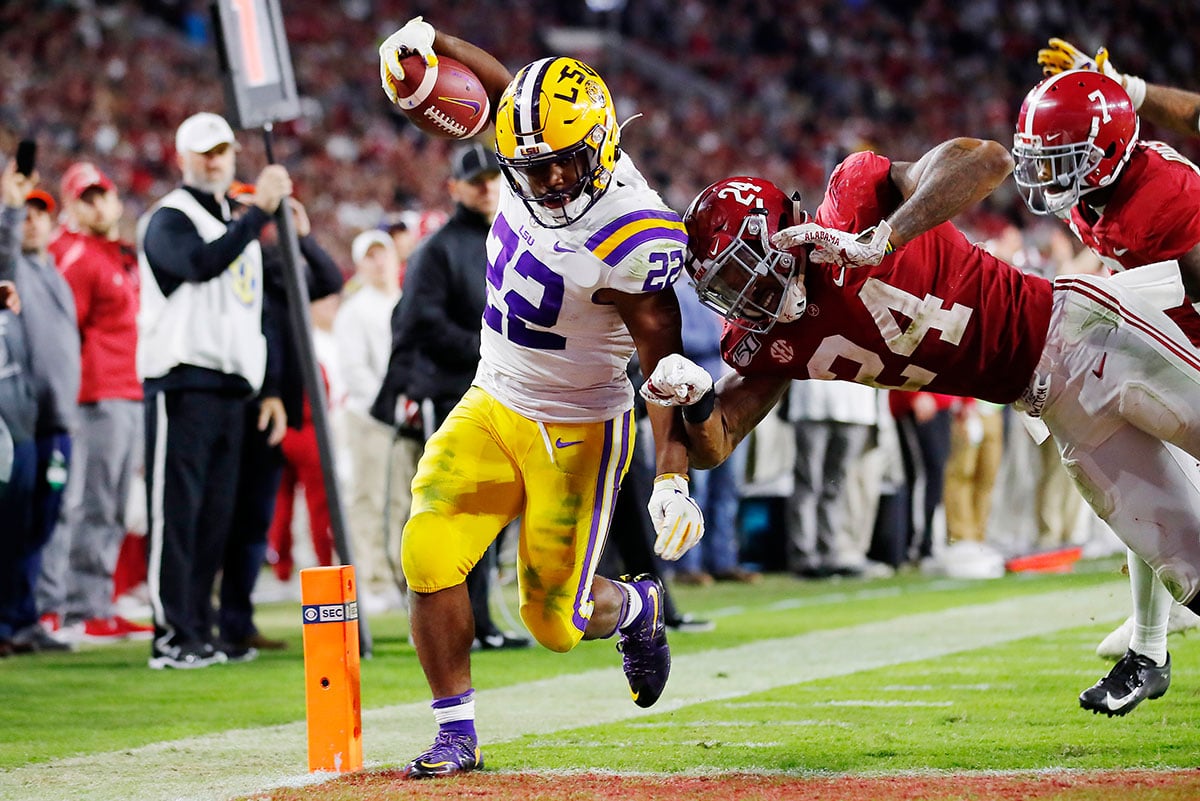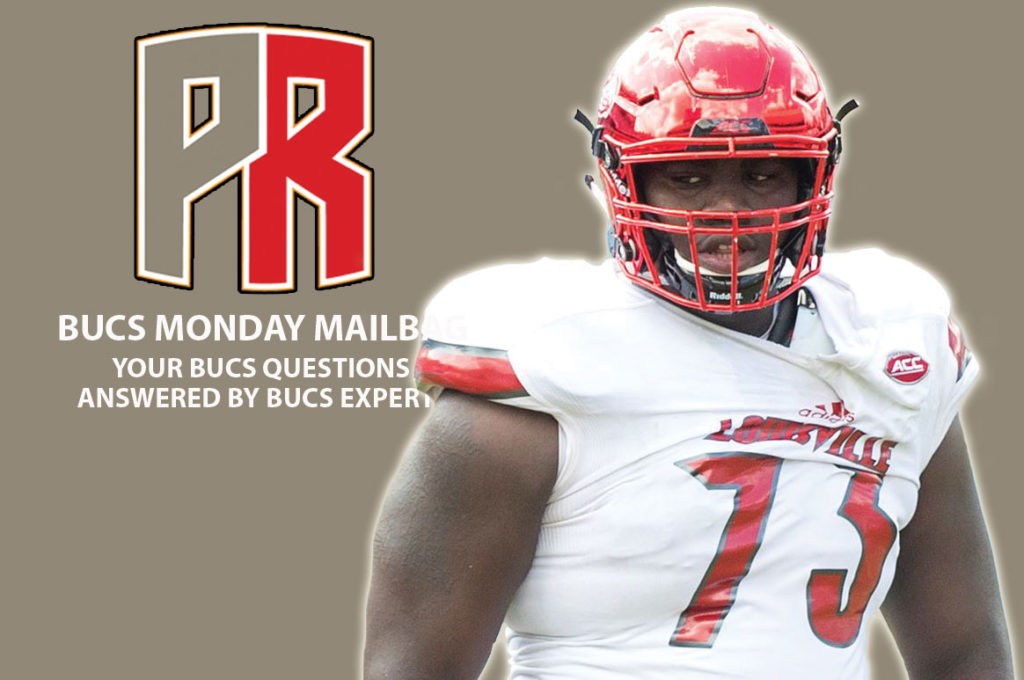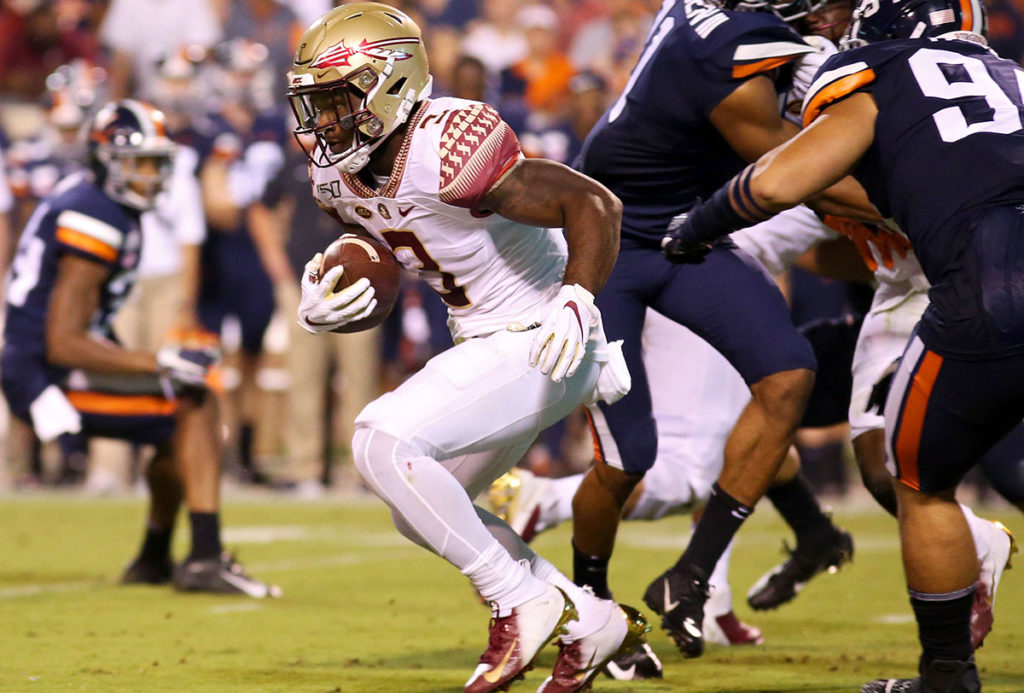The 2020 NFL Draft class offers at least six starting-caliber running backs before falling off dramatically, but there are still a couple of Day 3 options who can make an impact in a part-time role. I limited my rankings to 10 backs because, as I watched some prospects that didn’t make the cut (UCLA’s Joshua Kelley, Memphis’ Patrick Taylor, Jr.), I realized it wasn’t going to be productive for me to write about more late-round talents.
I’d like to get to Maryland’s Anthony McFarland, Vanderbilt’s Ke’Shawn Vaughn and maybe a few others before the draft, but given the dependency of running backs’ success on blocking and scheme, it’s not a position I typically prioritize a deep dive into during the draft cycle.
One note before we get started: I don’t factor positional value into my grades, so although plenty of the backs below carry a second-round grade in a vacuum, as an NFL team I probably wouldn’t consider any of them until at least Round 3. It’s unlikely they’ll make an above-replacement level impact consistently enough to be worthy of a valuable pick.
Enjoy!
10. A.J. Dillon, Boston College (6-0, 247, 4.53)
Dillon is a certified athletic testing freak for the running back position, running 4.53 and jumping 41 inches at nearly 250 pounds! Unfortunately, that athleticism does not show up on tape, as Dillon is much more of a plodding back than his 40-time would suggest.
The problem with over-hyping running backs’ 40 times is that the result rarely matters much for the position unless a prospect is prohibitively slow. You just don’t have big, chunk runs that often in the NFL, and if you do there is usually so much space for you to work in that it’s okay if you don’t have elite speed.
How running backs move in smaller areas is much more important, and that’s where Dillon leaves something to be desired. He’s mildly elusive for his size, but everything he does is pretty slow, and there isn’t much suddenness or explosiveness to his game. Combine that with a minimal receiving profile and you have a big, battering ram of a back who might find value near the goal line, but will likely never be a preferred every-down option in the NFL.
Grade: 5th Round
9. Darrynton Evans, Appalachian State (5-10, 203, 4.41)
Usually when non-Power 5 backs get attention it’s because they do one of two things: break a ton of tackles or show really dynamic ability in space with the ball in their hands. But … that isn’t Evans.
Don’t get me wrong, Evans’ vision and instincts as a runner are so good that he almost always puts himself in position to win on a given carry, and he can cut into creases of space without losing a ton of speed, which is valuable. But as much as Evans may win with his mind and his eyes, he simply doesn’t play to his athleticism very often, which limits his impact.
I think running backs like Evans grow on trees, so I’ll probably value him a little lower than others. He simply doesn’t offer anything special in the pass game, he has very little pass protection experience and he won’t make many defenders miss in space or in tight quarters. Evans is a good player who will get some run in an NFL backfield early in his career, but he’ll be pretty dependent on a great offensive line in order to make a major impact.
P.S. With Evans’ vision and speed, he might be an ideal return guy in the NFL. He had one kickoff return touchdown every year he was on the field at App. State. That will drive up his value for NFL teams.
Grade: 4th Round
8. Eno Benjamin, Arizona State (5-9, 207, 4.57)
Man, what a competitor. As aware as I am of the limitations of Benjamin’s game, it was fun to watch him compete on tape. I don’t get to watch many PAC-12 games during the college football season, so watching Benjamin throw his diminutive frame at edge rushers when releasing out of the backfield and bust his tail downfield to block for a scrambling Jayden Daniels was a lot of fun.
Benjamin can add value to the depth of any backfield because of his receiving ability, but beyond that he’s little more than a change-of-pace runner. His vision is spotty and his decision-making can be too aggressive for a player without elite athletic traits. Benjamin doesn’t break tackles at a high rate despite his willingness to take on tacklers, so he’s of little use when things get congested or trouble arises in the backfield.
He does catch the ball well (77 catches over the past two seasons) and has the intensity and elusiveness to be a factor in space, which gives him third-down value. I doubt we’ll ever see Benjamin in a feature role at the next level, but if he can improve his technique in pass protection, he can stick in the league.
Grade: 4th Round
7. J.J. Taylor, Arizona (5-5, 185, 4.61)
On tape I honestly wanted to put Taylor in Round 3, but the peripheral aspects of his evaluation (size, NFL Scouting Combine, fumbles) push his numerical grade into Round 4, which is still probably 2-3 rounds before he’ll get drafted.
Taylor does everything valuable at the running back position – elusiveness, burst, receiving, contact balance, routes – on a solid-to-great level, which will immediately get him a role on an NFL team if the depth ahead of him isn’t too significant. Guys like Taylor have tended to stick in the league despite size and athleticism limitations because they can be so valuable with the ball in their hands in space as a receiver or in the open field as a runner.
And don’t let Taylor’s size fool you. Being 185 pounds at 5-foot-5 means he is one rocked up dude, and he’s lowered the boom on several defenders throughout his career at Arizona. Taylor is extremely tough and physical, with way better contact balance than you’d expect given his size. Don’t get me wrong, Taylor won’t be a feature back in the NFL, but he should play a key role in a rotation if he can show his value as a receiver in camp.
The problem is that running backs who are his size and run 4.61 40s don’t get a lot of room for error in the NFL. They probably won’t get drafted high, or maybe at all, which puts them behind the eight ball before they even get started. Not only do they have to ball out on every limited preseason opportunity behind porous offensive lines, but they also can’t afford to make many mistakes.
That’s why, even though I’m confident that Taylor can play a productive role in the NFL, he’s at a position where he is somewhat reliant on who he sees the field with in order to leave a strong impression, so the climb is decidedly uphill. I’d stand on the table for him though.
Grade: 4th Round
6. Zack Moss, Utah (5-9, 223, 4.65)
Probably the best tackle-breaking back in the entire draft, Moss absorbs some crazy shots and keeps twisting and fighting and falling forward. He’s not a violent runner, but his balance through contact is awesome to watch, and it gets him out of some impressive jams. Combine that with good vision and a low center of gravity for a big back, and Moss is a handful for defenders one-on-one.
My biggest concern with Moss is that I’m just not sure he moves at the speed necessary to avoid taking tons of hits at the next level. Part of the reason Moss breaks so many tackles is because so many defenders get a chance to line him up. He’s not the quickest decision-maker and might require his blockers to hold their ground a bit longer than some other backs, so consider that as you will if you want him in a zone scheme at the next level.
Moss is a reliable pass-catcher with great hands who will run through tacklers in space, and that’s perhaps his most valuable asset. His lack of speed and explosiveness will limit the splash plays, but he’s still going to have more of an impact than most backs in the pass game. I like Moss, and at the cost it’ll likely take to get him, he might end up being the best value at the position in this class.
Grade: 3rd Round
5. Jonathan Taylor, Wisconsin (5-10, 226, 4.39)
If you’re one of those god-forsaken NFL offenses that is just determined to be built on the running game, I might consider making Taylor the first running back off the board. The best part about Taylor’s game is his vision and patience as a runner. He knows exactly where runs should hit, when to cut, when to wait, when to get low, etc.
Being technically sound isn’t the most valuable trait for a running back in the NFL these days, but there’s definitely some assurance in drafting Taylor that he will not get you fired. He’s an extremely safe bet to be at least a solid, productive NFL running back at the next level, and he should be scheme diverse as well, although inside zone could be his best bet at success.
The reason why Taylor slides down these rankings is that he lacks the dynamic ability to be as versatile a threat as many other backs in this class, especially in the passing game. While I like his upside in the passing game after finally getting involved last season, the reality is that Taylor’s hands are highly suspect and his routes and pass protection are still very raw.
Given the way data studies have shown that success in the ground game is predicated more on blocking and scheme than an individual runner’s ability, I gravitate toward scouting for impact in the passing game and in space when watching running backs. Do they catch the ball well? What kind of routes do they run? Can they make a man miss in space (as a runner or receiver)? Do they break tackles? Can they pass protect? Are they a home run threat?
With Taylor, the answers to the above questions aren’t always favorable. Outside of his routes and ball skills, Taylor also isn’t the most elusive back in space nor the most creative with the ball in his hands. He’s at his best keeping things on script, when it comes to creating space and making defenders miss, Taylor isn’t inept, it just isn’t his best qualities.
The science of a man his size with a low center of gravity and the speed Taylor can move at will break some lower body tackles, but Taylor isn’t a violent or aggressive runner despite his size and athletic tools. That’s kind of a disappointing part of his game, he just doesn’t have the edge or tenacity to his running style that guys like LSU’s Clyde Edwards-Helaire and even Florida State’s Cam Akers have shown during their college careers.
In the end I think Taylor can end up being a good three-down running back in the NFL, but I do question if he’ll ever be as dynamic of a threat as the backs listed ahead of him. He’s certainly a good player with great character and a bright future, but his landing spot will be more critical to his success than other backs in the class because he can’t make an impact in quite as wide a variety of ways in the NFL. At least, not yet.
Grade: 2nd Round
4. J.K. Dobbins, Ohio State (5-9, 209)
I’m not sure Dobbins will do anything at an elite level in the NFL, but he’s probably going to be one of the safest picks in the draft. There’s nothing he really does poorly, and he can contribute right away as a rusher, receiver and pass protector.
Dobbins is probably best fit for a zone scheme with his vision and one-cut style of play, but he was pretty successful at everything Ohio State ran. He doesn’t have the elite burst, elusiveness or tackle-breaking ability that I prefer in my favorite backs, but Dobbins is still good enough in all three areas to check the box.
Ohio State often targeted Dobbins in the passing game, so that part of his game should transition easily to the NFL and he averaged a healthy 10 yards per catch. He’s taken his lumps in pass protection, but he had plenty of stellar moments on tape, too. There’s no reason Dobbins can’t handle a strong workload for an NFL franchise, even if there’s a relatively low ceiling on how special he can be at the next level.
Grade: 2nd Round
3. Cam Akers, Florida State (5-10, 217, 4.47)
I’m going to be higher on Akers than most people, because I gravitate toward running backs who can create in a jam, break tackles and make defenders miss. Akers does all of those things well, consistently making something out of nothing behind Florida State’s horrendous offensive line.
There are times when he tries to do too much, but I don’t think Akers vision is as bad as his detractors make it out to be. Sure, he bounces a decent amount of runs, but a lot of time he’s right to do so, and he has enough burst to make it happen at times. He can’t “Saquon Barkley” the NFL and expect good results, but Akers isn’t an athletic slouch either, and behind better blocking the hope is he’ll have more patience and trust in his offensive line.
Akers’ pass-catching ability is a work-in-progress and he will drop some passes, but he’s effective after the catch and has plenty of experience being targeted in the passing game. Akers won’t hesitate in pass protection either, delivering one heck of a performance against Clemson in perhaps his toughest test of the season.
I think Akers’ best football is ahead of him, and he’s already pretty darn good. He’s a running back, so the landing spot will matter a lot, but I’d take a slight risk on a back that can create like he can over safer options that teams will likely gravitate toward.
Grade: 2nd Round
2. D’Andre Swift, Georgia (5-8, 212, 4.48)
Remember, most running backs as pure rushers are very dependent on their blocking and scheme for success, at least until they work through the initial wave of defenders and into more space. Swift epitomizes this, as he doesn’t have the vision and anticipation to move linebackers and create creases up front for himself, but if you can get him through the initial hole with speed, he’s a nightmare at the next level.
Swift’s ability to make cuts at full speed also aid him as a route runner, where he consistently gets open even when aligning in the slot. He’s also surprisingly solid in pass protection for a smaller back, which will only add to his value as a rookie.
Swift isn’t a 20-25 carries-a-game type of back, but in today’s NFL that’s not a huge deal. Put him in a zone scheme behind a quality offensive line, let him play fast and make sure you get him touches in space, and you won’t be sorry with what he brings to the table.
Grade: 2nd Round
1. Clyde Edwards-Helaire, LSU (5-7, 207, 4.60)
If height and long speed are your top priorities for evaluating running backs, Edwards-Helaire probably won’t be for you. But you also probably haven’t been very successful at evaluating running backs, so let’s take a look at what CEH does offer.
Edwards-Helaire has elite vision and timing as a runner, frequently manipulating second-level linebackers before bursting through a crease up front. He’s a bowling ball to approaching defenders, using his nasty demeanor and low center of gravity to pick up yards after contact and break tackles at one of the highest rates in the nation.
But not only is he an excellent pure runner, but Edwards-Helaire is also the most accomplished receiving back in the class, catching 55 passes for 453 yards and doing it from a ton of alignments. He’s a detailed route runner (for a college running back) with reliable hands and the ability to make opponents miss after the catch.
In essence, there really isn’t much to be disappointed about in CEH’s game. He’s a great runner, a great receiver, he pass protects, he doesn’t fumble, he plays every snap 100 miles an hour and he doesn’t come off the field. Running backs are extremely dependent on their environment (blocking and scheme) for success on the ground, but CEH is the safest bet in the class to make an impact at the next level.
Grade: 2nd Round
Jon Ledyard is PewterReport.com's newest Bucs beat writer and has experience covering the Pittsburgh Steelers as a beat writer and analyzing the NFL Draft for several draft websites, including The Draft Network. Follow Ledyard on Twitter at @LedyardNFLDraft




